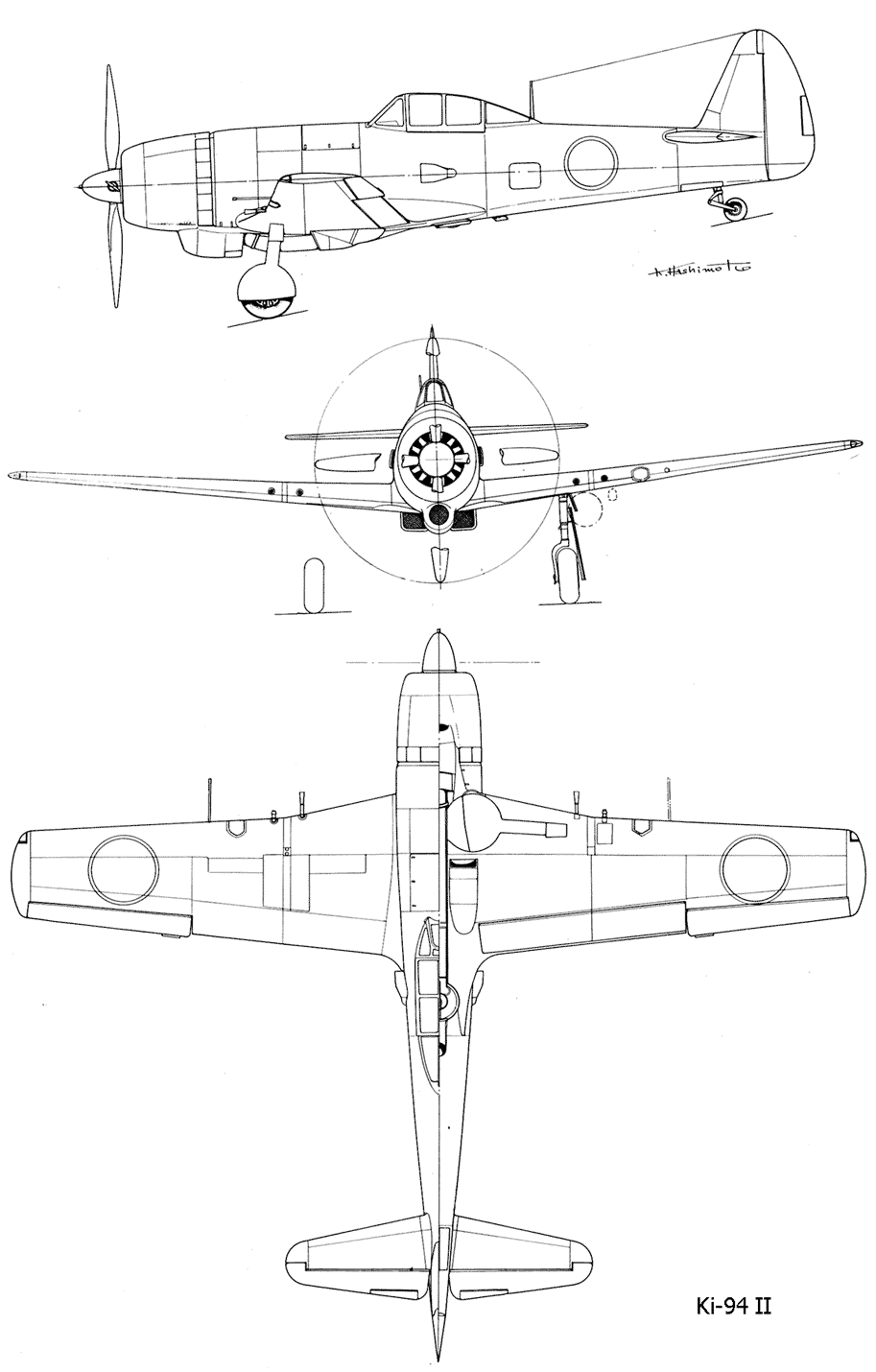
Aviation of World War II


 |
Aviation of World War II |


|
|
Soviet Union | Lend - Lease | Facts | Forum | Germany | Japan | R A F | U S A A F | Other | Photos |
|
|
Ki-94
|
|
|
Ki-94 II
|
||||||||||||||||||||||||||||||||||||||||||||||||||||||||||||||
| Tachikawa | Ki-94 | Ki-94 II |
|---|---|---|
| Crew | 1 | |
| Dimensions | ||
| Wing span, mм | 15.00 | 14.00 |
| Wing area, m² | 37.00 | 27.96 |
| Length, m | 13.05 | 12.00 |
| Height, m | 3.85 | 4.61 |
| Powerplant | ||
| Piston Engine | Mitsubishi 2×Ha-211 Ru |
Nakajima 1×Ha-44-12 (Ha-219Ru) |
| Power h.p. | 2×2172 | 1×2420 |
| Weight, kg | ||
| Empty | 5,200 | 4,690 |
| Gross weight | 9,400 | 6,956 |
| Performance | ||
| Maximum speed, km/h | 780 | 712 |
| Cruising speed, km/h | 548 | 440 |
| Service ceiling, m | 14,000 | 14,680 |
| Service range, km | 2,100 | |
| Photo | Description |
 |

April 12, 2019
Ki-94 I scheme with tandem engines borrowed from the Dutch Fokker D.XXXIII captured by the Germans as a war trophy during a five-day military campaign on May 10-14, 1940. The problem of low power Fokker liquid engines was solved by installing powerful radial engines, leaving the aircraft in an emergency was carried out through the lower hatch in the niche of the front landing gear with the blades removed. However, nobody canceled Newton's laws. In an emergency landing, kinetic energy in the form of half the mass of the rear engine times the SQUARE of speed will tend to crush the cockpit.
---

Siemens Schuckert DDr with 1 MV tandem Powerplant
November 28, 2019
Let's dwell on table of flight characteristics of Dornier aircraft with a tandem engine layout. For Do 355B-1 with two DB 603 E-1 engines with 1800 hp each the maximum speed is indicated at 760 km / h. For the Japanese Ki-94-I with a power plant of 2 × 2172 hp, with a power of 744 hp. more than that of the Do 335, the predicted speed should be higher, however, it remained in history only in the wooden model. Subsequent variants of the combined power plant made sense only with the placement of the jet engine behind, hoping to achieve high speed and range at the same time.
---
November 27, 2019
Ki-94-I was developed according to the scheme with a tandem arrangement of engines in the fuselage, patented by K. Dornier in 1937, and used by him in the German "Arrow" Do-335 . Compared to the "Pfeil" on the Ki-94, the engines were located at a small distance from each other and were separated only by the cockpit, which obviously reduced the moment of inertia and improved the maneuverability of the aircraft.
Obviously, with such a scheme, the engines rotated through 90° had the opposite rotation, which solved the problems with the reaction of the propeller, in addition, the air-cooled engines, which have a large midship, well protected the pilot in front and behind from attacks in the front and the rear hemisphere.
The beams and the wing easily accommodated powerful cannon armament outside the plane of the propeller throwing.
Small midsection of the power plant with its capacity of 4344 hp. from. promised a significant increase in speed up to 780 km / h at an altitude of 10,000 m.
---